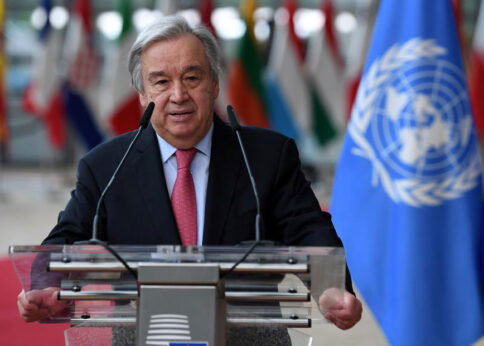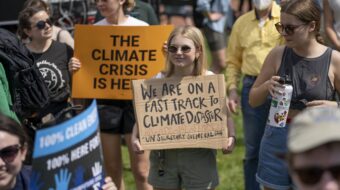
With the world facing a “climate abyss,” all eyes are on Glasgow, Scotland, where the U.N. Climate Change Conference (COP26) will convene Oct. 31-Nov. 12. Global leaders, elected officials, environmental activists, scientists, and business leaders will gather in what may be humanity’s last best opportunity to adopt a path that averts ecological catastrophe.
Over 120 world leaders will attend to announce plans or nationally determined commitments (NDCs) to reduce greenhouse gas emissions by 2030 and net-zero emissions by 2050. The Paris Agreement called for emissions reductions to keep the global temperature increase to 1.5°C; the COP26 meeting will show how closely countries stick to that limit.
“The overarching ambition that we have got is that we want to be able to say with credibility coming out of Glasgow, that we have kept 1.5 within reach, 1.5 alive,” declared COP26 president Alok Sharma at an Oct. 26 press briefing. “And I think over the past year or so, we have made progress.”
Over 50 countries have announced net-zero-by-2050 pledges. Among them is the U.S., the world’s leading polluter per capita. President Joe Biden, who will attend in person, is expected to detail U.S. plans to achieve a 50% reduction in emissions by 2030 and net-zero emissions by 2050, via what he calls an “all of government” approach.
Biden’s first executive orders returned the U.S. to the Paris Agreement and reversed Trump’s anti-environment agenda. As Biden left Washington Thursday, the administration and Democratic-controlled Congress reached an agreement on a framework for Build Back Better legislation that would make a historic investment in reducing carbon emissions.
Among the top polluters, only China and India have not announced their NDCs, although, in December 2020, China pledged its emissions would peak by 2030 and be carbon-neutral by 2060.

Recent comments by Sharma and U.N. Secretary-General António Guterres give grounds for optimism, tempered by the reality of the monumental challenges the world still faces. The announced pledges leading up to the conference are a big step forward but still leave humanity and nature far short of what is needed.
Sharma said pre-Paris, scientists forecast global temperatures to rise by around 6°. But now, as a result of national actions, the rise is approximately 4°, still unacceptable.
“And I think the latest reports that you have seen make the point that if all the commitments, the NDC commitments, as well as, of course, the net-zero commitments, are delivered on by individual countries, we are heading towards 2°,” he said. “So, the curve has been bent downwards. I think that is welcome. But of course, what we’re talking about is trying to keep 1.5 within reach.”
Sharma was referencing a recent report by the International Energy Agency. According to the IEA report, current pledges cover less than 20% of the emissions reduction gap that needs to be closed by 2030 to keep a 1.5°C path within reach.
The devil, of course, is in the details. It depends not only on new and more ambitious commitments to reduce greenhouse gas emissions but implementing the plans and anticipating the fact that governments will modify them along the way.
“The carbon pollution of a handful of countries has brought humanity to its knees. And they bear the greatest responsibility,” said Guterres at a press briefing on Oct. 21. “The G20 nations are responsible for four-fifths of planet-eating carbon pollution. If they do not stand up and lead these efforts, we are headed for terrible human suffering. My message is clear: Do not fiddle with half-measures and shallow promises while our planet burns.”
Based on pledges, Guterres is deeply worried but still hopeful about getting to 1.5°C. The collective effort of humanity is required, he said, from both developed and emerging economies. All nations need to arrive at Glasgow with bold, front-loaded strategies to decarbonize every sector of their economies.
Central to getting to 1.5°C is ending reliance on coal as an energy source. Guterres called for all advanced economies to quit coal power by 2030 and all other economies by 2040. And those goals may be within reach given the steep and rapid decline in the cost of renewable energy, which is now far cheaper than coal. However, the IEA predicted coal usage to be down 20% over recent highs by 2030.
“I would just ask us all to reflect on where we have come from, where we were just at the beginning of the year,” said Sharma. “We have gotten to a position where we now have all of the G7 signed up to no more international coal financing. We’ve also got South Korea, which has signed up to no more international coal financing. And then you saw at the U.N. General Assembly, China also stepped forward and said no more international coal financing.”
The old carbon polluting economic development model is a dead-end, economically and environmentally, said Guterres. “Solidarity is essential. Many countries in the developing world will need support to make this shift as they struggle with COVID and spiraling debt crises.”
Developing economies need assistance from developed economies to mitigate emissions, adapt to the climate crisis, and build resiliency against sea-level rise, droughts, resource allocation, and extreme weather. These effects of the climate crisis are already exacerbating tensions and conflicts, creating millions of climate refugees.

Guterres called on developed countries to provide financial and technical support through bi-lateral agreements and global financing mechanisms. One mechanism is the creation of a $100 billion global fund to help developing countries transition to renewables over the next five years.
“It’s a matter of trust (by developing countries toward developed countries),” he said. “That trust has been undermined by the vaccine problem, inequitable economic recovery, and the global financial situation. Credible plans to materialize the $100 billion fund are a fundamental condition to rebuilding trust.”
He called upon governments and multi-national financial institutions to immediately assist developing economies in addressing adaptation and resilience. Many countries in South Asia, Africa, and Central America are on the front lines of the climate crisis, “with devastating consequences for their societies,” facing sea-level rise, droughts, and extreme weather events.
The global community also remains very concerned about U.S.-China relations. Biden has identified China as a strategic competitor, continued Trump’s tariffs on Chinese imports, and carried on with a military build-up in the South China Sea that is fueling tensions between the two countries. Without cooperation between the world’s two economies, it’s hard to see achieving net-zero emissions by 2050.
“The Paris agreement would not be possible without an effective cooperation agreement between the U.S. and China,” said Guterres. “And I fear that the geo-political divisions today will make it difficult to reach the same level of cooperation which I personally think will be key. Because China and the U.S. are the two biggest polluters. And both China and the U.S. need to do more. They need to do more than they have been announcing up to date.”
There is hope, despite the late “wake-up call” for humanity. Until seven years ago, Guterres said, recognition by global public opinion that the world was nearing the point of no return was lacking. He blamed the mass disinformation campaign conducted by the fossil fuel companies.
Guterres said things moved slowly until recently. Besides climate-related natural disasters, it took a combined upheaval in civil society, especially among youth, recognition in much of the private sector that the future is in the green economy, and technological advances that are driving down the cost of renewables to make a decisive turn.
This combination of factors “has finally created in the last two years a clear consciousness that we are really on the verge of the abyss. It took time, but my hope is we are not too late.”
RELATED STORIES:
> Manchin kills Biden’s clean energy plan, leaving states and cities to lead
> COP15 pushes biodiversity crisis to top of agenda before U.N. climate meeting
> Manchin, who pockets $500,000 per year from dirty coal, kills critical Biden climate deal
> Biden’s climate measures must pass or he’ll go empty handed to COP26












Comments